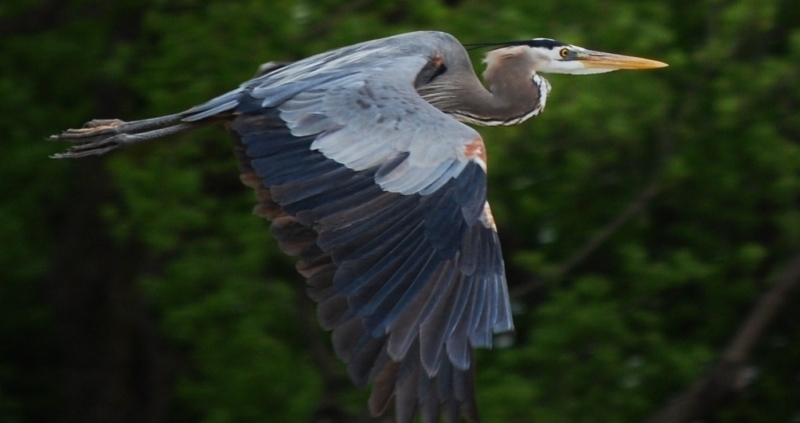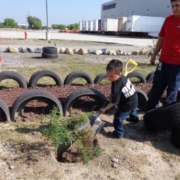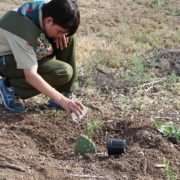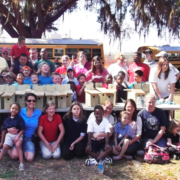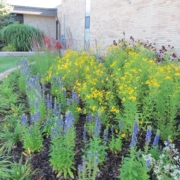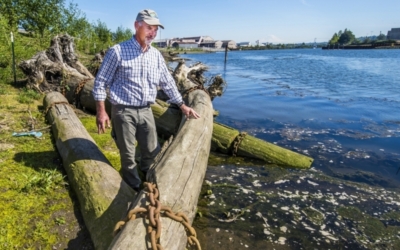BASF | Preserving and Enhancing Biodiversity for the Community
As a member of WHC, BASF has worked to establish wildlife habitat and conservation education initiatives on their lands since 2002. With WHC Conservation Certification programs in the U.S. and Canada, BASF’s commitment to preserve and enhance biodiversity is a priority for the organization as they pledge to conduct business in a manner that is responsive to the environmental and economic needs of the communities in which they operate.
The Gold-Certified conservation program at BASF’s Fighting Island facility exemplifies this pledge, offering unique and innovative learning experiences for local students.
Fighting Island, a 1,500-acre island on the Canadian side of the Detroit River in LaSalle, Ontario, has been transformed into a resource for local schools and community members with biodiversity restoration projects and educational facilities.
The island was historically used for storage of lime tailings, a byproduct of soda ash production, in settling beds. Since closing the settling beds in 1982, BASF’s efforts have led to native revegetation and reforestation to help prevent erosion, reduce dust, increase wildlife habitat, control runoff, and enhance the island’s appearance.
BASF currently maintains multiple conservation projects on the island, including invasive species control, native tree and shrub plantings, bat houses, pollinator habitat, and native game bird reintroductions.
Since 2004, BASF, in conjunction with Essex County schools, turned the island into an outdoor classroom, providing a hands on learning environment that has hosted more than 30,000 students from the local community.
BASF successfully incorporates the use of advanced technologies with outdoor STEM learning for local students.
The education project at Fighting Island provides local elementary and secondary school students with a classic STEM learning experience in which educational activities are structured around a practical experiment-based approach using the island’s habitats as the basis for cultivating problem-solving and critical thinking skills.
The curriculum used at the site was developed specifically for the facility by the employee volunteer team, Essex County teachers and school administrators, and aligns with Ontario’s academic standards.
Technology is a mainstay of the curriculum and allows students to experience real-world scenarios, much in the way that scientists and researchers do. The island’s four portable classrooms, known as environmental labs, are equipped with computers, monitoring equipment and microscopes. A high-resolution projection camera streams video from a microscope or specimen dish to the computers, which allows the entire class to view insects, aquatic macroinvertebrates, and other samples gathered in the field. The monitoring equipment includes special devices that can be taken into the rugged field environment.
These devices capture, analyze, annotate, store and print data wirelessly, and connect to a number of
sensors for monitoring pH, dissolved oxygen, conductivity, temperature, weather, water quality, and GPS position in the site’s wetlands and ponds.
A particularly valuable aspect involved with using these devices is that students also make qualitative observations and then compare those to the data gathered with the sensors, enabling them to understand how the methodology and equipment can affect the results of experimentation.
The conservation program at Fighting Island demonstrates how BASF supports the communities in which they live and work, and contribute to a world that provides a viable future with enhanced quality of life for everyone.
Related Content
- White Papers:
- Relevant President’s Blog or Wildlife Blog posts
-
- A Hands-On Approach to Building the STEM Workforce of Tomorrow
- Let’s Go Outside! The Benefits of Learning in the Outdoors
- The Importance of Aligning Your Projects with Learning Standards
- Hands-On Means Minds-On
- Habitat Design that Invites Exploration
- Celebrate World Wetlands Day on February 2
- Back to School: Partnering with Local Schools to Strengthen Your Certification Program
-
- Project Guidances:
- WHC Webinars:
- Five Star Grants: A Good Fit for Companies and Their Community Partners
- The Three “E”s to Success: Employees, Education and Engagement
- Measuring the Success of Your Conservation Education Projects
- Event Planning 101: How to Host a Successful Community Event at Your Habitat
- Incorporating Project Learning Tree into Your Educational Projects
- Wetland Habitats: Identification, Monitoring and Use as Outdoor Classrooms
- Building a Program on Your Remediation Site
- STEM Learning in Your Habitat
- Building Effective Partnerships: Case Studies
Quick Facts
| Site Name: | Fighting Island |
|---|---|
| Category: | Member Spotlight |
| Tags: | Awareness and Community Engagement, formal learning, landscaping, Remediation Member Spotlight, Reptiles and Amphibians, wetlands |
| Site Location: | LaSalle, Ontario, Canada |
| Partners: | Catholic School District, Greater Essex County School District, J&J Marine |
| Certification Since: | 2002 |
| WHC Index Link: | View Project |
